Patricia & Diego
Things to do and see

Porto - Explore the bustling Cais da Ribeira
This riverfront promenade is postcard Porto, taking in the whole spectacular sweep of the city, from Ribeira's pastel houses stacked like Lego bricks to the barcos rabelos (flat-bottomed boats) once used to transport port from the Douro. Early-evening buskers serenade crowds, and chefs fire up grills in the hole-in-the-wall fish restaurants and tascas (taverns) in the old arcades. Da qui si può ammirare l’intera città. Da Ribeira con le facciate delle case di color pastello attaccate l’un l’altra come mattoncini Lego, alle “Barcos Rabelos” (barche a chiglia piatta) chec venivano utilizzate nel passato per trasportare i vini dall’entroterra fino alla città tramite il fiume Douro. Non mancano intrattenimenti nelle strade interne dove si potranno ammirare bancarelle di prodotti artigianali e cibi tipici e sarete accompagnati da serenate di musicisti di strada. Per vivere un esperienza più tipica potrete entrare nelle taverne-osmize tipiche chiamate “tascas”.
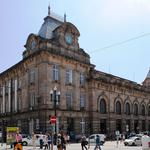
Porto - Snap Insta-worthy azulejos of São Bento Station
One of the world's most beautiful train stations, beaux arts São Bento wings you back to a more graceful age of rail travel. Completed in 1903, it seems to have been imported from 19th-century Paris, with its mansard roof. But the dramatic azulejo panels of historical scenes in the front hall are the real attraction. Designed by Jorge Colaço in 1930, some 20,000 tiles depict historic battles (including Henry the Navigator's conquest of Ceuta), as well as the history of transport. São Bento ti riporta ad un'epoca più aggraziata dei viaggi in treno. Completata nel 1903, sembra essere stata importata dalla Parigi del 19 ° secolo, con il suo tetto mansardato. Ma i drammatici pannelli azulejo (piastrelle di ceramica dipinte di azzurro) di scene storiche nella sala anteriore sono la vera attrazione. Progettato da Jorge Colaço nel 1930, circa 20.000 piastrelle raffigurano battaglie storiche (tra cui la conquista di Ceuta da parte di Enrico il Navigatore), così come la storia dei trasporti.
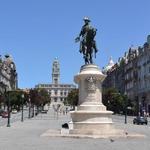
Porto - Take a selfie in Avenida dos Aliados
Lined with bulging, beaux arts facades and capped by the stately câmara municipal (municipal council), this avenida recalls grand Parisian imitators such as Buenos Aires and Budapest. The avenue's central plaza was restored a few years back and often hosts pop-up book, comic and art festivals and exhibitions. Fiancheggiata da facciate sporgenti in stile Beaux-Arts e sormontata dalla maestosa “câmara municipal” (consiglio municipale), questa avenida ricorda i grandi imitatori parigini come Buenos Aires e Budapest. La piazza centrale del viale è stata restaurata qualche anno fa e spesso ospita mostre e festival di libri pop-up, fumetti e opere d'arte.

Porto - Find the perfect book in Livraria Lello
Ostensibly a bookshop, but even if you’re not after books, don’t miss this exquisite 1906 neo-Gothic confection, with its lavishly carved plaster resembling wood and a stained-glass skylight. Feels magical? Its intricately wrought, curiously twisting staircase was supposedly the inspiration for the one in the Harry Potter books, which JK Rowling partly wrote in Porto while working here as an English teacher from 1991 to 1993. The €5 entry is redeemable if you buy a book. Apparentemente una libreria, ma anche se non sei alla ricerca di libri, non perderti questa squisita confezione neogotica del 1906, con il suo intonaco riccamente scolpito che ricorda il legno e un lucernario in vetro colorato. Ti senti magico? La sua scala intricata e curiosamente tortuosa è stata presumibilmente l'ispirazione per quella nei libri di Harry Potter, che JK Rowling scrisse in parte a Porto mentre lavorava qui come insegnante di inglese dal '91 al'93. L'ingresso di 5€ è riscattabile se acquisti un libro.
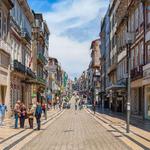
Porto - Walk down Rua de Santa Catarina
This street is absurdly stylish and romantic, striped stone footpaths and animated crowds. It's home to Porto's most ornate tearoom, the art nouveau Café Majestic, and the extraordinary azulejo-bedecked Capela das Almas. Questa strada è molto stileggiante e romantica, marciapiedi in pietra a strisce e folle animate. Ospita la sala da tè più elaborata di Porto, l'art nouveau Café Majestic e la straordinaria Capela das Almas decorata con azulejos.

Enjoy the portuguese custard tart in Fábrica da Nata
Whilst in Rua Santa de Catarina enjoy a custard tart with a coffee or a glass of Porto wine in Fabrica da Nata (highly recommended!). Porto has tailed Lisbon with a nata factory that churns out silky fresh-baked pastéis de nata (custard tarts) throughout the day. Throw €1 in the slot machine at the counter and you’ll be presented with a crispy tart to eat in or take away. Process can be repeated as necessary. Mentre sei in Rua Santa de Catarina, non perderti la leggendaria crostatina alla crema pasticcera (Pastel De Nata) con un caffè o un bicchiere di vino Porto a “Fabrica da Nata” (altamente raccomandato!). Porto ha seguito Lisbona con una fabbrica di crema che sforna fresche paste setose (crostate alla crema pasticcera) diariamente. Inserisci 1€ nella slot machine al bancone e ti verrà presentata una crostata croccante da mangiare o da asporto. Il processo può essere ripetuto se necessario.

We challenge you to try a Francesinha before leaving Porto
Portuguese francesinhas deserve all the honors possible. This typical Invicta dish, created in the 50's, conquers both hearts and bellies every day, and even the tourists can't seem to resist it. Scattered throughout the city, so you will be sure to cross paths with a few as you discover Porto, there are examples of francesinhas for all tastes and even less traditional variations, such as vegetarian or chicken instead of red meat. Le “Francesinha” portoghese merita tutti gli onori possibili. Questo piatto tipico Invicta, creato negli anni '50, conquista ogni giorno cuori e pance. Nemmeno i turisti riescono a resistere. Servite in moltissimi ristoranti in tutta la città, ne incontrerete sicuramente alcune alla scoperta di Porto, ci sono esempi di francesinhas per tutti i gusti e varianti anche meno tradizionali, come quella vegetariana, o di pollo al posto della carne rossa.

Porto - See the sights of Sé Catedral
From Praça da Ribeira rises a tangle of medieval alleys and stairways that eventually reach the hulking, hilltop fortress of the cathedral. Founded in the 12th century you can noticie the church’s Romanesque origins in the barrel-vaulted nave. Inside, a rose window and a 14th-century Gothic cloister also remain from its early days. Witness of history, this is where Dom João I married his beloved Philippa of Lancaster in 1387, and where Prince Henry the Navigator was baptised in 1394. Da Praça da Ribeira sale un groviglio di vicoli e scalinate medievali che alla fine raggiungono l'imponente fortezza collinare della cattedrale. Fondata nel XII secolo, si possono intravedere le origini romaniche della chiesa, tuttavia, si riconoscono ancora nella navata voltata a botte. All'interno rimangono anche un rosone e un chiostro gotico trecentesco. Testimone di molta storia, è qui che Dom João I sposò Filippa di Lancaster nel 1387, e dove fu battezzato il principe Enrico il Navigatore nel 1394.

Porto - Admire the Bolsa Palace
This splendid neoclassical monument honours Porto’s past and present money merchants. Just past the entrance is the glass-domed Pátio das Nações (Hall of Nations), where the exchange once operated. But this pales in comparison with rooms deeper inside; visitable every 30 minutes. The highlight is a stupendous ballroom known as the Salão Árabe (Arabian Hall), with stucco walls that have been teased into complex Moorish designs, then gilded with some 18kg of gold. Splendido monumento neoclassico onora i mercanti di denaro passati e presenti di Porto. Oltre l'ingresso si trova il Pátio das Nações (Sala delle Nazioni), con la cupola di vetro, dove un tempo operava lo scambio. Ma questo impallidisce in confronto alle stanze più profonde; per visitarli, partecipa a una delle visite guidate di mezz'ora Il clou è una stupenda sala da ballo conosciuta come Salão Árabe (Sala Araba), con pareti in stucco che sono state prese in giro in complessi disegni moreschi, adornate con circa 18 kg d'oro.
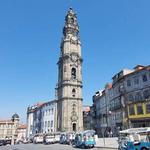
Porto - Climb the Clérigos Tower
Sticking out on Porto's skyline like a sore thumb – albeit a beautiful baroque one – this 76m-high tower was designed by Italian-born baroque master Nicolau Nasoni in the mid-1700s. Climb its 225-step spiral staircase for phenomenal views over Porto's tiled rooftops, spires and the curve of the Douro to the port-wine lodges in Gaia. It also harbours an exhibition that chronicles the history of the tower's architects and residents. Questa torre alta 76 metri, che si staglia sullo skyline di Porto come un pollice dolente, sebbene sia una bellissima torre barocca, è stata progettata dal maestro barocco di origine italiana Nicolau Nasoni a metà del 1700. Sali la sua scala a chiocciola di 225 gradini per una vista fenomenale sui tetti di tegole, le guglie e la curva del Douro di Porto fino alle logge del vino porto a Gaia. Ospita anche una mostra che racconta la storia degli architetti e dei residenti della torre.
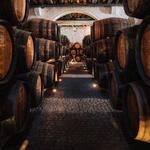
Enjoy a port tasting while discovering the lore of Porto’s favourite drink - Cais de Gaia
Portugal’s famous port lodges are located in Porto’s cross-river sister city Vila Nova de Gaia. Gaia, as it’s more commonly called, is easily reached via a stroll or metro ride across the iconic Ponte de Dom Luís I, which was built by a disciple of Gustave Eiffel (of Eiffel Tower fame). Tour and taste Porto’s eponymous tipple at vintage cellars such as Ramos Pinto, Graham’s or Taylor’s, with the latter offering stellar views of the Douro River from its rooftop terrace. Le famose cantine di vino Porto si trovano nella città gemella di Porto, Vila Nova de Gaia, che attraversa il fiume. Gaia, come viene chiamata più comunemente, è facilmente raggiungibile con una passeggiata o un giro in metropolitana attraverso l'iconico Ponte de Dom Luís I, costruito da un discepolo di Gustave Eiffel. Visita e assaggia l'omonima bevanda di Porto in cantine vintage come Ramos Pinto, Graham's o Taylor's, con quest'ultima che offre viste stellari sul fiume Douro dalla sua terrazza panoramica.
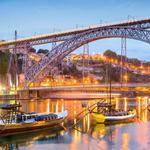
Porto - Cross the bridge Dom Luís I
Completed in 1886 by a student of Gustave Eiffel, Porto's most eye-catching bridge is a city icon. It was built to replace a precarious crossing between Porto and Vila Nova de Gaia made from old port boats lashed together – most would agree that its curving arch adds a definite something to the cityscape. From the upper deck, the views over the river and old town are stunning. Keep an eye out for daredevils who leap from the lower level into the river. Completato nel 1886 da uno studente di Gustave Eiffel, il ponte più accattivante di Porto è un'icona della città. È stato costruito per sostituire un precario incrocio tra Porto e Vila Nova de Gaia fatto di vecchie barche portuali legate insieme - la maggior parte concorderebbe sul fatto che il suo arco ricurvo aggiunge qualcosa di definito al paesaggio urbano. Dal ponte superiore, la vista sul fiume e sulla città vecchia è sbalorditiva. Tieni d'occhio i temerari che saltano dal livello inferiore nel fiume.

Porto - Stroll amid the gardens and the panoramic views of Palácio de Cristal
Watch the peacocks parading the grounds for photos and scope out the small gardens scattered across the park’s eight hectares (20 acres). The southern part of the park has sweeping views over the town. Eventually, zigzag your way back down to the river. Guarda i pavoni che sfilano sul terreno per le foto e osserva i piccoli giardini sparsi negli otto ettari del parco (20 acri). La parte meridionale del parco offre ampie vedute sulla città. Alla fine, torna a zigzag verso il fiume.
Porto - Festas de Sao Joao
São João festival in Porto is celebrated on June 23rd, and it usually begins with a dinner between friends/family, in a restaurant or on a barbecue at a friend’s place. The typical dishes of São João festival in Porto are grilled sardines, grilled peppers, caldo verde (the famous Portuguese green broth soup) and fresh tomato salad. The meat lovers usually go for grilled spare ribs, or for some beautiful bifanas (pork sandwiches). Many people choose restaurants in Ribeira, right next to D. Luís bridge, where fireworks take place at midnight, or in Foz (a neighborhood after Ribeira, also close to the riverside). Another great location for restaurants is the Douro river bank on the Gaia side. Not surprisingly, the fireworks at D. Luís bridge is the high point of the night of São João festival in Porto. Check out - https://www.youtube.com/watch?v=wLpYzGPYpuE&embeds_euri=https%3A%2F%2Fwww.eurodicas.com.br%2F&source_ve_path=MzY4NDI&feature=emb_logo
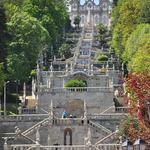
Lamego - Climb the steps of Santuário de Nossa Senhora dos Remédios
One of the country’s most important pilgrimage sites, this twin-towered, 18th-century church has a trim blue-and-white stucco interior with a sky-blue rococo ceiling and a gilded altar. The church, however, is quite overshadowed by the zigzagging monumental stairway that leads up to it. The 600-plus steps are resplendent with azulejos (hand-painted tiles), urns, fountains and statues, adding up to one of the greatest works in Portuguese rococo style. It’s a dramatic sight at any time, but the action peaks in late summer when thousands of devotees arrive and ascend the steps in search of miracles during the Festa de Nossa Senhora dos Remédios. Most offerings are made at the rear altar where Mother Mary reigns supreme. If you can’t face the climb by foot, a road (turn-off 1km out on the Viseu road) winds up the hill for about 3km before reaching the top. Nossa Senhora dos Remedios is 15min by car from our venue Paraiso Douro. Our venue Paraiso Douro is located in the town of Lamego.
Lamego - Scalinata del Santuario Della Nostra Signora dei Rimedi
Uno dei luoghi di pellegrinaggio più importanti del paese, questa chiesa del XVIII secolo con due torri ha interni in stucco blu e bianco con un soffitto rococò azzurro cielo e un altare dorato. La chiesa, tuttavia, è abbastanza oscurata dalla scalinata monumentale a zig-zag che vi conduce. Gli oltre 600 gradini risplendono di azulejos (piastrelle dipinte a mano), urne, fontane e statue, che si sommano a una delle più grandi opere in stile rococò portoghese. Questo spettacolo drammatico raggiunge il picco a fine estate quando migliaia di devoti arrivano e salgono i gradini in cerca di miracoli durante la Festa de Nossa Senhora dos Remédios. La maggior parte delle offerte viene fatta all'altare posteriore dove Madre Maria regna sovrana. Se non riesci ad affrontare la salita a piedi, una strada si snoda su per la collina per circa 3 km prima di raggiungere la cima. Nossa Senhora dos Remedios è a 15 minuti in auto da Paraiso Douro. L'hotel Paraiso Douro si trova nella città di Lamego.